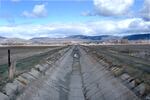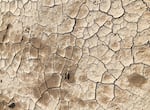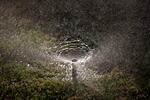
In this March 2010 photo, an irrigation ditch stands dry on the Klamath Irrigation District near Klamath Falls, Oregon.
Jeff Barnard / AP
A stark red blotch on the U.S. Drought Monitor map spreads outward from the intersection of Klamath, Lake and Deschutes counties, marking the quarter of Oregon that’s experiencing “extreme” and “exceptional” drought. Even the damp forests and fertile farmlands of the Willamette Valley are cloaked in the orange of “severe” drought.
We use many words to describe drought and its intensity, but what drought actually means — and what it means for us — can be difficult for people whose brains don’t think in acre-feet.
So OPB asked a few experts to help make sense of what’s shaping up to be one of the worst drought years in state history.
What is drought?
Simply put, drought is a water shortage. It’s typically the result of long periods with insufficient precipitation.
“It can have many manifestations, but in its simplest form, that’s what it is,” said Larry O’Neill, Oregon’s state climatologist and an associate professor at Oregon State University.
We measure drought based on historical expectations or norms.
Ecosystems have adapted to a certain amount of water availability. For example, plants and animals in the temperate rainforest zones of Western Oregon require, relatively speaking, a lot of water. Those in the desert east of the Cascades generally require less by comparison.

Water sloshes at the Bull Run Watershed Management Unit in this Dec. 3, 2019, file photo. The Bull Run Watershed serves the Portland metro area.
Kaylee Domzalski / OPB
Humans have similarly built societies around available water. We have things like irrigation canals and pipes, municipal water systems, and groundwater wells to help deliver the water we need for drinking, farming, recreation, etc.
Drought is what happens when we fall short of that expectation. It means there isn’t enough water to meet the needs of all who use it — humans, plants, fish and wildlife.
“And we start to feel impacts because we need to start changing some of the things we do to accommodate that, to basically get through that period,” O’Neill said.
What isn’t drought?
Drought takes months to form and months — sometimes longer — to recover from, so it isn’t over just because it rains once.
Oregon historically had well-defined wet seasons and dry seasons. Rain soaks the state, mostly the west side, through fall, winter and spring. Meanwhile, snow accumulates in higher elevations to form snowpack, which is sort of like our savings account to draw down during the dry summer.
The ideal, especially on the east side, is for that snowpack to melt slowly and evenly throughout the summer until the next wet season arrives.
Part of the trouble this year is a lot of the state is coming off a drought last year, which means we’re operating at a deficit. Soils are that much drier; groundwater and reservoir levels are that much lower.
“We’re really dependent on this wet season that we’re now leaving to recover some of that moisture that we didn’t get last year,” O’Neill said. “And it didn’t happen.”

The dry bed of Detroit Lake is pictured in this Oct. 25, 2015, file photo.
Courtney Sherwood
Still, drought isn’t solely due to a lack of precipitation.
Some places are naturally dry, but that doesn’t necessarily mean they’re always in drought, says Portland State University assistant professor of geography Alida Cantor.
“It’s just a dry place,” Cantor said. “[Drought is] when we’re expecting to do more with the water than what we have.”
Why is this year’s drought so bad?
As just mentioned, part of the reason is 2020 was also a bad drought year. This year’s La Niña winter also failed to deliver enough much-needed precipitation.
The water year starts Oct. 1 and runs through Sept. 30 of the following year. Last fall was dry, and this spring was dry. While this winter featured some large, powerful storms, they still weren’t enough to make up the deficit. Stack that on top of the lingering effects of last year’s drought, and you’ve set the conditions for a severely dry summer.
“If you’re not reestablishing the groundwater, and you’re not building up those stream flows going into winter, you’re starting in deficit mode,” Scott Oviatt, the snow survey supervisory hydrologist for the Natural Resources Conservation Service of Oregon, recently told OPB.

Researchers measure the snowpack on Mount Ashland in Southern Oregon in this 2018 file photo.
Jes Burns, OPB/EarthFix
And then, of course, there’s the undercurrent of climate change.
Earth goes through wet periods and dry periods naturally. However, state climatologist O’Neill said mounting evidence suggests this part of the planet is currently enduring the driest 20-year period in the past millennium. Global warming is driving a “slow drying out of the landscape” that will outlast drought in the present.
“As the atmosphere starts to warm up, it increases the ability to pull moisture out of both the soil and any vegetation … so that we can’t use it,” O’Neill said.
He added that this slow drying out is expected to continue even as we exit our current dry period and enter a wet one.
“So when we do go back from a wet period to a dry period, the droughts will be more intense because there’s going to be less moisture starting out in that period,” he said.
The state’s latest climate assessment, released in January, indicates Oregon is likely to see more precipitation in coming years, but less of it will be snow. Cascade snowpack is also particularly vulnerable to changes in temperature and will likely start melting out earlier.
Therefore, droughts could become longer and more severe, which will have major implications on lives and livelihoods in the Northwest.
What does drought mean for me?
That answer varies depending on where you live and what you do for a living. Drought is, at its core, a stressor on individuals, communities and ecosystems, but its effects are not evenly distributed.
“A lot of times, for a lot of people, you might not necessarily know that we’re in drought,” O’Neill said. “The thing to remember is that a lot of people are very vulnerable to fluctuations in the amount of water they have.”
Drought forces difficult decisions about how to divvy up the available water supply. The decision-making process can produce heated conflicts, especially in places where drought is severe and long-lasting like in the Klamath and Deschutes basins.
Those decisions are made even messier with the tangled web of water rights that convey power to rights-holders who, in Oregon, can use water without regard for more junior rights holders.

This Oct. 1, 2002, photo shows one of the tens of thousands of adult salmon that died on the Klamath River in Northern California when drought exacerbated chronic water quality problems.
Joe Cavaretta / AP
Water shortages can damage habitat and hurt populations of ecologically and culturally significant wildlife. Farmers and ranchers can experience economic losses that lead to financial hardships. Outdoor recreation opportunities diminish. Food prices sometimes increase. Drought can also lengthen and intensify our wildfire season.
Cantor with Portland State, whose research focuses on management of water resources, says perhaps the biggest misconception about drought is that we simply don’t have enough water to go around.
“I think we’ve just been expecting too much for too long in terms of what our water can do in the Western United States,” Cantor said. “We’re just over-using our water resources overall, and there’s plenty of water to go around if we use it right.”
How can I help?
About 80% of consumptive water use in the United States is for farming, according to the U.S. Department of Agriculture. The nation’s biggest water users are governed by a litany of federal, state and local laws. Changes at that scale will have the largest impact on water availability.
This year, water supply forecasters have urged water managers in many Oregon river basins to prepare for significantly reduced supplies.
Cantor said it’s important for individual consumers to think outside-in.
Lots of attention gets heaped on actions like taking shorter showers, but the water savings of a hygienic dousing are paltry compared to letting your lawn go dry or ripping it out entirely. Fixing household leaks can also save huge amounts of water.

A sprinkler waters the lawn of a home on Wednesday, May 18, 2016, in Santa Ana, California. Some parts of the country have offered incentives to homeowners to rip out their lawns in order to save water.
Jae C. Hong / AP
We’re also starting to learn more about how individual dietary choices affect water availability. Researchers with the University of Michigan and Tulane University recently published a study that measured the “water scarcity footprint” of individual diets.
The study says consumers can lower their personal water scarcity footprint by limiting beef (which also lowers your carbon footprint) and turning instead to beans and seeds or less water-intensive meats like chicken. People can also substitute less water-intensive vegetables like kale, brussels sprouts and peas for more water-intensive ones like broccoli and asparagus.
Martin Heller is a senior research specialist with the University of Michigan’s Center for Sustainable Systems and the study’s lead author. He says the research adds another layer of information to help people understand how our food choices affect not just our own health, but also the environment.
“It shouldn’t end at carbon,” Heller said. “We need to take into account these other resources that are required to produce our food as well.”
